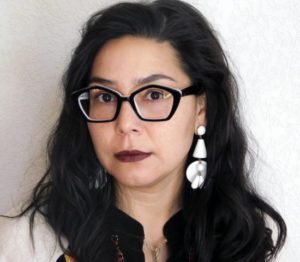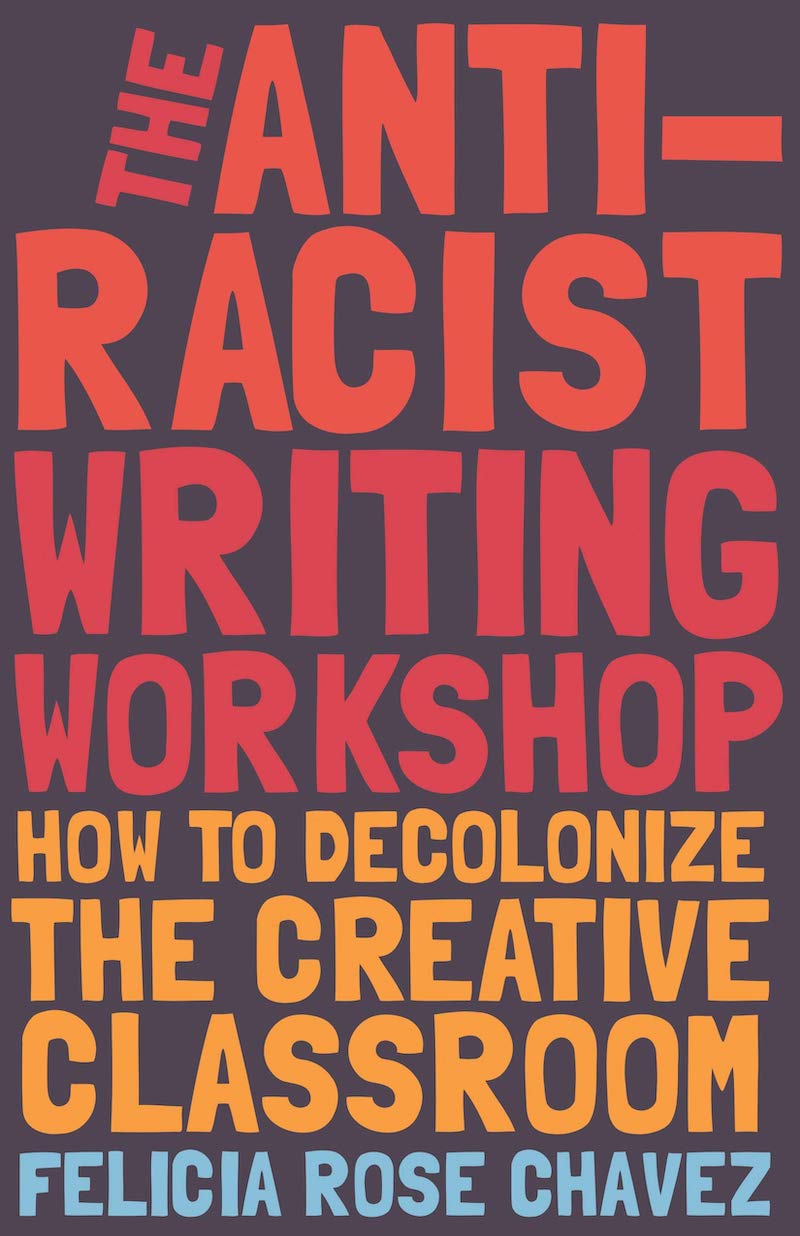
Felicia Rose Chavez is at the forefront of anti-racist pedagogy. In her new book, The Anti-Racist Writing Workshop: How to Decolonize the Creative Classroom, Chavez combines her personal story with tested teaching strategies that dismantle oppression. The book offers a blueprint of specific actions to deconstruct biases, design democratic teaching models, and recruit, nourish, and fortify students of color.
This hybrid memoir/manual extends from over a decade of experience as an innovative creative writer and award-winning teacher. Chavez holds an MFA in Creative Nonfiction from the University of Iowa, and has most recently co-edited The BreakBeat Poets Volume 4: LatiNEXT with Willie Perdomo and José Olivarez. She has also earned numerous teaching awards. From The University of New Mexico, she was named Most Innovative Instructor of the Year; from The University of Iowa, Outstanding Instructor of the Year; Colorado College, the Theodore Roosevelt Collins Outstanding Faculty Award. These awards can only gesture at the flowering impact of The Anti-Racist Writing Workshop, a book that has made so many readers, writers, and teachers rejoice. As Sarah González of Mil Mundos Bookstore writes, “I feel seen!”
In this interview, held over a shared .doc while still in the middle of a pandemic, we discuss the challenges and joys of implementing anti-racist practices. Of note, Felicia Rose Chavez and I attended graduate school together. It was a gift to be able to reconnect after a decade.
***
The Rumpus: How do you introduce and contextualize the anti-racist writing workshop for students?
Felicia Rose Chavez: I remember a colleague asking me this question during a phone consultation. After an hour together reimagining her syllabus, she asked, “But what do I say to my students? What makes this pedagogy anti-racist?” I rambled that it’s a model of deep listening, kindred community, mindfulness, generosity. “Oh, wow,” she said, seeing through to the heart of it. “You’re talking about a deeply human approach to teaching.” I’ll never forget that.
The anti-racist workshop is human-to-human connection: I see you, I hear you, you exist. There’s power in that, as so often people of color are erased from English classrooms. Every one of us is an embodied individual with a name and a writing legacy. We root out traditions of domination and control that we think equates with authority in the classroom. We check our egos and collaborate as artistic allies, each with our own aesthetic preferences and visions for our writing. The point is to nurture voice so that we may more fully participate as global citizens. I
t took me about thirty years to be able to just say “no” when I wanted to say “no.” That’s a deep-rooted issue for a lot of folks, no matter your personal background. It’s especially problematic for people of color, women, queer, and working-class students. We look at a creative classroom and we see a contained experience, when, really, it’s a lifelong journey in owning your voice, owning it on the page and owning it aloud. The anti-racist workshop offers students agency to exercise voice: they select their own readings, collectively define craft concepts, write to please themselves, moderate their own feedback sessions, and assess their individual writing journeys, without fear of free-reigning bias.
Rumpus: As students learn to guide their own workshops and learn to ask questions of their own work, what challenges arise? What joys?
Chavez: In my course evaluations from this past fall, three of my fifteen students reflected that they learned empathy. Imagine that! Empathy. These were first-year students who did not self-select into my class, students who on day one swore they weren’t creative. Others claimed a sense of peace while writing, ownership of their ideas, and my favorite, pride as writers. No one cited learning proper grammar or how to write a strong intro. Instead, they reflected on how they changed as people.
I directly correlate these successes to the anti-racist workshop. When students honor their artistic lineage—honor their mentors and stay true to their artistic preferences—then they’re emboldened to take risks on the page. The work is truly theirs. And suddenly, the stakes are a lot higher. No longer are they writing for the professor or in competition with their peers or toward a grade. Instead of a passive “What did you think?,” workshop evolves into an active “Here’s what I need from you to evolve my vision.” That’s hard work, articulating your process, your vision, your needs. It requires both humility and confidence, vulnerability and trust. It requires time—we spend a good deal of class practicing how to ask questions. But because students are invested, because they truly own their work, it’s meaningful to them.
Rumpus: What is the relationship between reading and writing in the anti-racist classroom—how is that relationship a part of anti-racist practice?
Chavez: I’m a big believer that students’ own writing is the required text of study. Instead of memorizing model texts, why not study one another’s words? My students write by hand and read their work aloud daily (raw, messy free-writes, so as to normalize imperfection). Hearing a writer’s words from their own mouth is a powerful means of reclaiming sidelined narratives. It invites a more complex engagement: students feel empowered to write as they speak, including writing in dual languages. Early on, their free-writes confront the emotional and psychological hardships of writing: I’m afraid I’m not good enough; I’m afraid my family will hurt if they knew I was writing this; I’m afraid the workshop will think I’m stupid or weird or boring. We acknowledge the cultural imperative of silence that so many people of color struggle against, and we collectively commit to writing anyway. As the class goes on, we share our works-in-progress aloud in informal variations on workshop (pairs, small groups, large group), doing away with the masculinist myth of suffering in solitude. All of this reading aloud influences our treatment of one another’s texts. We mine the work for craft over content, adhering to the writer’s agenda over our own, because we’re aware that the text came from a real, whole person, someone who is writing past fear to achieve their own authentic voice on the page.
Rumpus: The book names the “heart of the wound.” You write: “writers of color are charged with convincing white leaders that our stories are believable, relatable, universal.” It is up to the professor to create “a human to human dialogue on authorial intent.” You go on to say: “isn’t listening at the heart of critique.” In your experience, what happens when writers are listened to? Really listened to? Can you talk about the role of listening as an anti-racist practice?
Chavez: Students tell me that they feel seen for the first time in my class. What they mean, I think, is that they feel heard, recognized as fully embodied individuals deserving of respect. Listening is the first and most important step to maintaining a storytelling tradition. Together we train in how to address one another by name through a ritual of daily check-in. We train in mindfulness, monitoring our body language so that we truly receive one another’s words. “Are you ready?” I ask, and students instinctively inhale, adjust their posture, and nod. We train in how to sidestep ego, listening to one another’s work without an appeal for our opinion. Most importantly, we train in how to listen to ourselves. What is your name? I ask. You have the right to claim space. Where do you come from? I ask. You are endowed with a storytelling legacy. Who are your artistic mentors? I ask. Your knowledge is legitimate. What do you fear? I ask. You are in a safe space. What do you want? I ask. You are free to risk failure. Why are you good at writing? I ask. You are, and have always been, a writer. Listening to ourselves, trusting in our inherent worth, is essential to decentering white supremacy both on and off the page.
Rumpus: The book moves beautifully between memoir and pedagogical guide. We learn parts of your personal story in which you share your experience with the expansive oppression of conventional creative classrooms (in which the writer is silenced as those in the room respond) and find new pathways towards anti-racist approaches. As you wrote about these painful wounds, what did you carry with you to give you strength? What texts or music?
Chavez: When I finished editing the manuscript, my final step was to write a series of letters to the authors whose books towered beside me on the nightstand table (I wrote most of the book in bed, pregnant, or else in the rocking chair, my infant son strapped to my chest). They were love letters. Sandra Cisneros, bell hooks, Claudia Rankine, David Mura, Kiese Laymon, Peter Elbow, and of course June Jordan, to whom I dedicate the book’s preface. “I would never have attempted this project if it weren’t for you,” I wrote, over and over again. The project wasn’t complete until I thanked my mentors, the torchbearers of this work. It felt right to offer gratitude, there’s real joy there. Gratitude, too, for my older son’s mock whispers of “I’m not bothering you but where is my other shoe?” Gratitude for the balmy Louisville walks and the Ravensburger puzzles and the coffee pot and the texts from my brother saying you got this, Felicia. Taking care is in the love.
Rumpus: Many colleges and universities are making their antiracist commitments explicit through public statements. Your book offers a blueprint for them to actualize those commitments. In this moment of multiplying hardships, pandemics, and financial and institutional instability, why is it so vital to go beyond the statements and implement anti-racist practices?
Chavez: Because our customer demands better. Students from across the country are calling us out on institutional, structural, and individual racism. “Evolve or die,” as poet Donna Kate Rushin says in “The Bridge Poem.” Which will it be? A few years back, my students invited the English Department Chair, an older white man, to sit in on my class in a very sweet effort to convince him to keep me on staff (as a Visiting Assistant Professor, my position ended that year). He stayed maybe fifteen minutes. Later he told me, “I couldn’t believe my eyes. This is what the students deserve. It’s time for me to retire.” And he did retire, a year later. There’s electricity in the air, he could feel it, see it in action. Nowadays, students are straight up requesting their professor’s retirements in formal letters to the administration. Just last week I met with Iowa alumni of color who graduated from the Nonfiction Writing Program ten years before me as well as current students of color who will graduate ten years after me. “There were so few of us split between each year,” one woman said. “We couldn’t support one another then. We couldn’t actualize real change. But now, together, we can.” The time for change is now. We must evolve.
***
Photograph of Felicia Rose Chavez courtesy by Idris Goodwin.





